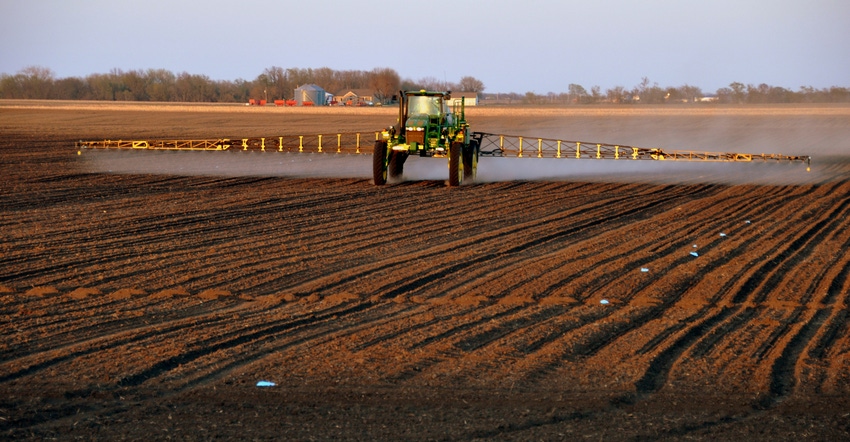
Lower preemergence herbicide rates are the source of agriculture’s rising weed resistance problem, says Bureau County, Ill., farmer Matt Foes.
Why? He says farmers have “selected for” herbicide-resistant strains of weeds such as waterhemp in their attempt to save on preemergence costs — a decision enabled by Roundup Ready cropping systems. Since the ’90s, Roundup labels have said if farmers used the herbicide postemergence, they could halve preemergence rates.
Foes, who also holds a master’s degree in weed science, explains that lower preemergence applications are bound to result in larger and more weeds, because they’re allowed to grow earlier than they would under the full labeled rate. Larger weeds are more likely to develop resistance, and having more weeds increases the odds.
When farmers can’t get in the field to apply postemergence herbicides, it worsens the issue, says Karen Corrigan of McGillicuddy Corrigan Agronomics.
“We got a little complacent with Roundup Ready technology. I don’t recommend using reduced rates anymore,” Corrigan says.
That hefty preemergence rate will help keep weeds under control, so they won’t reach a size where the postemergence herbicide will struggle to control them.
“You shouldn't expect Roundup to kill 12-inch waterhemp. It used to, but it was never intended to,” Corrigan says. “Postemergence programs often fail because the weeds are too big by the time they get sprayed.”
Foes says while Roundup was always treated as a “backstop” — a way to make up for low preemergence rates — he’s seen its effectiveness gradually diminish during postemergence applications. Enter dicamba, another broad-spectrum herbicide that, like Roundup, kills broadleaf weeds.
“Dicamba works for now; however, if we use the same approach or rely upon it so heavily, we will end up in the same place with more resistance and less effectiveness,” Foes says. “We need to do our heavy hitting with preemerge now, which is a change in mindset.”
Managing dicamba
Aaron Hager, a University of Illinois weed scientist, has recommended full preemergence rates since the ’90s. He says if you’re going to plant a dicamba- or Roundup-resistant seed variety, you ought to do everything you can to make sure the crop realizes its yield potential.
“If you cut your preemerge, you may have every intention of being timely with post, but you’re betting on the weather. The likelihood that you won’t be timely goes up because the residuals won’t last as long,” Hager says.
Full preemergence rates are becoming more important, Hager says, partly because of potential regulations for dicamba. While the Illinois Department of Agriculture isn’t putting a cutoff in place for dicamba-based herbicides, the idea to stop spraying 45 days after planting was considered in 2018.
“Let’s say you’re spraying 21 days after planting instead of 30 because you limited your preemerge. Now you have 25 more days of control, but you’re running up against that cutoff and may not be able to get another application in when you see weeds,” Hager says.
While dicamba can be the cure-all for many fields’ broadleaf weed problems, Foes argues that exclusive reliance on it will inevitably lead to more resistance and declining effectiveness.
“We’ve got to spread the workload among at least two herbicides that target both grasses and broadleaves, and use the full rate to minimize the amount of work dicamba has to do,” Foes says. “The more weeds we rely on dicamba to control, the more likely it is that we’re going to find one in that population that won’t die — that is resistant.”
Start clean, stay clean
Residual control through full label rates is the key to fighting the resistance problem in weeds emerging in soybean fields. But Foes says it’s also important to know the weed you’re targeting.
Marestail and waterhemp are his two main concerns — as well as stray volunteer corn in his dicamba-resistant soybean fields.
He started his weed management in November by vertical tilling to kill many of the marestails that had germinated in his otherwise no-till fields. In the spring, he plans to do a burndown application of dicamba and glyphosate before planting to finish off any winter annual weeds.
“We really strike the field clean. From there, waterhemp is my main concern,” Foes says.
He applies a full rate of a Group 15 residual herbicide, but does so after soybean emergence in late May. This early-post application is timed so the full residual control window is present during waterhemp emergence in late May through early July.
“I’m starting the clock on my residual control in late May, and it runs until July. We’re wanting the heart of that four to six weeks to be when waterhemp is emerging,” Foes says.
The volunteer corn is taken care of with a postemergence application of grass-targeting graminicide.
Foes acknowledges that his strategy on his farm in northern Illinois may be different from what would work for other farmers in the state.
“Marestail can germinate in the spring down at the southern end of the state. So there, you might want to time your period of residual control earlier,” Foes says.
About the Author(s)
You May Also Like




